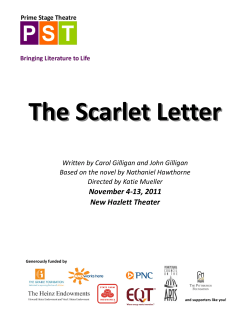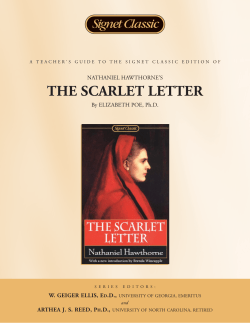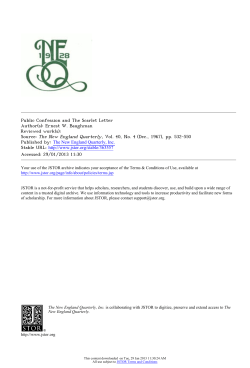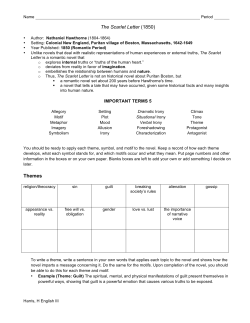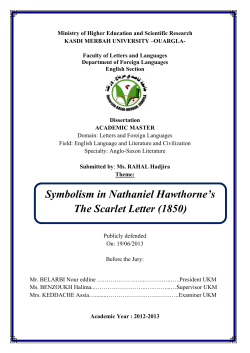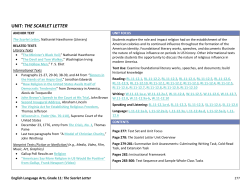
The Scarlet Letter Study Guide
THE GLENCOE LITERATURE LIBRARY Study Guide for The Scarlet Letter by Nathaniel Hawthorne i Meet Nathaniel Hawthorne We are made better by all that he writes. ––Evert Augustus Duyckinck, editor and reviewer Copyright © by The McGraw-Hill Companies, Inc. N athaniel Hawthorne had a low opinion of autobiography and refrained from writing one. In fact, his wife once said, “He had a horror that his life would be written.” Although Hawthorne did not write the story of his life, he left behind a wealth of material—journals, letters, unfinished manuscripts, and published works— that reveal who he was and how he lived. Hawthorne was born in Salem, Massachusetts. Generations of Hathornes—as the name was formerly spelled—had lived in Salem. Hawthorne was well aware of their status in the community, though that status was not always admirable. For example, Hawthorne lived with the knowledge that his great-great-grandfather, a judge in the 1692 Salem witch trials, was responsible for the deaths of some of the accused witches. Scholars have concluded that Hawthorne keenly felt the burden of his ancestry and assumed the guilt of his Puritan grandfathers. When Hawthorne was four years old, his father, a sea captain, died while on a voyage. Hawthorne’s mother, Elizabeth, took the boy and his two sisters to live with her affluent brothers. In this chaotic, crowded, multiple-family home, young Hawthorne somehow managed to foster a love of reading. n The Scarlet Letter Study Guiden After graduating from college, he did not assume a career. He knew only that he was determined to one day become a writer. His first literary work, begun during college, was titled Fanshawe. He used his own money to have it published, but soon decided it simply wasn’t good enough to be made public, and so he tried to destroy all the copies that had been printed. All told, Hawthorne spent a dozen years after college reading and writing. He lived with his mother in Salem during this period. Gradually, he met with success; he sold some short stories, which were published under a pseudonym. Finally, in 1837, he published Twice-Told Tales, a collection of short stories, under his own name. Hawthorne continued to write short stories for magazines, but he made only a modest living. After marrying Sophia Peabody in 1842, he appealed to several friends for help in finding a job, and they were able to obtain for him a position at the Salem custom house. He lost his job in 1848, a circumstance that he resented and wrote about in “The Custom-House,” the introductory chapter of The Scarlet Letter. Soon after he lost his job, his mother died. In the midst of his grief, he wrote The Scarlet Letter, which was published in 1850. Hawthorne himself felt it to be a gloomy story about a risky subject, but the book met with some success, eventually ensuring Hawthorne’s place in literary history. Though Hawthorne achieved fame, he was not necessarily comfortable playing the role of revered author. He was shy and avoided making eye contact with people. At home, he was likely to head out the back door if he knew a guest had arrived at the front door. At times he was playful, almost childlike, and unconcerned about appearances. Yet he was a good friend to other authors, including Herman Melville, who dedicated Moby Dick to him. More than a century after his death, Hawthorne is still revered as a father of American literature. From this man came, according to Henry James, “the finest piece of imaginative writing yet put forth” in America. Introducing the Novel 10 Many consider Hawthorne to be the first writer to truly represent American perspective and style in a work of fiction. Prior to Hawthorne, no American novelist had yet made an impact on Europe’s literary circles. According to Henry James, a later American novelist and critic, “the publication of The Scarlet Letter was in the United States a literary event of the first importance.” Along with others, James felt “a satisfaction in the idea of America having produced a novel that belonged to literature, and to the forefront of it.” Born and raised in the United States, Hawthorne steeps his novel in the early American past, creating characters and a plot that reflect the very roots of American culture. THE TIME AND PLACE The Scarlet Letter is set in the mid-1600s in Boston, which had been founded only about two decades earlier. In 1630 hundreds of newly arrived Puritans established a number of settlements in Massachusetts. The Puritan movement began in the 1500s among people who believed that the Church of England was too much influenced by the Crown and the Catholic Church. As Protestants, the Puritans rejected the belief that divine authority is channeled through any one particular person, such as a pope. Puritans believed that people had the power to receive spiritual enlightenment directly from the teachings of the Bible. The kings and queens of England did not always agree with the Puritans. When Charles I closed Parliament in 1629 and pressured Puritan members to conform, some Puritans traveled to the American colonies to gain religious freedom and establish new lives. The colony of Massachusetts began as a trading firm called the Massachusetts Bay Company. The president of the company was called the governor. A deputy-governor, filled the role of vice-president. Eighteen assistants served as the equivalent of a board of directors. The investors, or stockholders, were freemen. The stockholders made up the General Court, which met four The Scarlet Letter Study Guidenn Copyright © by The McGraw-Hill Companies, Inc. Hawthorne wrote The Scarlet Letter in an astonishingly short period of time—between the fall of 1849 when his mother died and February 3, 1850, when he repeatedly read the conclusion of the novel to his wife. It tells the story of Hester Prynne, a young woman, in the Puritan town of Boston in the mid-1600s. Hester, found guilty of adultery, is sentenced to wear a scarlet letter A on her chest for the rest of her life. The story also involves her daughter, her daughter’s father, and her husband, who arrives in Boston after a prolonged absence. Using these circumstances as the framework for his novel, Hawthorne weaves around his characters a psychologically powerful tale of the consequences of breaking a moral code. Skillfully, Hawthorne investigates how guilt and sin operate on the innermost workings of his characters’ minds. Literary scholars have hailed Hester Prynne as the first true heroine of American literature. Hawthorne characterizes her as a whole person— woman, mother, sinner, and member of the community—rather than as a stereotype, as so many writers at that time cast their female characters. In an era when most novelists were concerned with detailed portrayals of the outside physical world, Hawthorne presented mental and emotional truths. In a critical analysis of Hawthorne, Roy R. Male, English professor at the University of Oklahoma, writes: Hawthorne possessed what one of his friends called “the awful power of insight,” and his fiction remains valuable chiefly because of its penetration into the essential truths of the human heart. Preferring to concentrate on the darker, often hidden areas of the human psyche, Hawthorne turns a scrutinizing eye on the thought processes and emotions that occur within the mind of the individual. Even the otherwise modest Hawthorne admitted that “some portions of the book are powerfully written.” Readers and reviewers agreed with him in spite of its subject matter, which was considered very risqué in the mid-1800s. times a year to elect company officers and vote on company affairs. Once the Company was established in Massachusetts, its leaders created a colony. Company officers became the governmental leaders. These leaders had been prominent men in England, and some held royal titles. All were securely seated in the established upper class and were accustomed to ruling. Similarly, the freemen were accustomed to being ruled. These residents of Boston in the mid-1600s were much as Hawthorne depicts them—hardworking and devoted to their way of life. Their society had been carved out for them by John Winthrop, the first governor of Massachusetts and a resident of Boston. As a leader of the first residents of the colony, he established a government based on a combination of religious and civil ideals. The colony was intended to be an ideal Christian community. Copyright © by The McGraw-Hill Companies, Inc. Did You Know? Though Hawthorne always had doubts about the quality of his work, he was especially concerned about The Scarlet Letter. He felt the story was too bleak, and so he wrote what he called an introductory essay to add interest for his readers. In a letter to Horatio Bridge dated 4 February 1850, Hawthorne wrote: There is an introduction to this book— giving a sketch of my Custom-House life, with an imaginative touch here and there—which perhaps may be more widely attractive than the main narrative. Scholars disagree as to the value of “The The Scarlet Letter Study Guide Custom House.” Many feel, contrary to Hawthorne’s opinion, that the novel stands well enough on its own without the essay. “The Custom House” is semi-autobiographical. Hawthorne is generally considered to be the narrator, and speaks of his work at the Custom House, of losing that position, and of his Salem ancestors. The narrator supposedly discovers Hester Prynne’s embroidered letter and some notes about what happened to her. The narrator feels compelled to tell her story, but unable to do so in the stifling atmosphere of the Custom House. Upon being released, however, the 11 Before You Read The Scarlet Letter Chapters 1–8 FOCUS ACTIVITY How does our society punish people who break the law? Discuss In a small group, talk about shame and what role it plays in the punishment of criminals. Determine whether modern-day punishments include bringing shame upon those who break the law. Setting a Purpose Read to find out what part shame plays in the punishments inflicted by colonial Boston’s penal code. BACKGROUND Stereotyping One element of The Scarlet Letter that made this novel unique for its time was its lack of stereotyping. In literature a stereotype is a character who is not developed for his or her own personal traits but as a collection of traits and mannerisms that are shared by other people who are members of that group. For example, a stereotyped villain is evil and heartless. The hero or heroine pitted against that villain is often portrayed as compassionate, strong, or good-looking. Most heroes have an unusually well-developed sense of right and wrong. Unlike other writers of his time, Hawthorne avoided stereotypical characters and shallow characterization. He fully developed his characters by examining what made them human. He moved boldly into areas that some readers of the time might have found shocking, such as guilt, adultery, and social judgment. Did You Know? Laws in colonial Massachusetts covered everything from swearing to excessive decoration on women’s caps to murder. Whipping, branding, and other forms of public humiliation were relatively common practices in the colonies. Hester Prynne’s punishment was mild by Puritan standards. Copyright © by The McGraw-Hill Companies, Inc. VOCABULARY PREVIEW [ed5@ fis] n. building ensue [en soo $$$5 ] v. to take place afterward feign [fa$n] v. to pretend gesticulation [jes tik2y@ la$5sh@n] n. expressive gesture ignominy [ig5n@ min2e$] n. deep humiliation; disgrace inauspicious [i n 2o ^ s pish5@s] adj. unfavorable panoply [pan5@ ple$] n. full suit of armor; impressive array tribunal [trK$ bu$n 5 @l] n. court or meeting at which a trial is carried out edifice 12 The Scarlet Letter Study Guide Name Date Class Active Reading The Scarlet Letter Chapters 1–8 All four of the main characters are introduced in this first section of the novel. As you read, note the main qualities of each character. In each circle, write adjectives that describe that character, based on Hawthorne’s characterization. Hester Prynne Roger Chillingworth Copyright © by The McGraw-Hill Companies, Inc. courageous Arthur Dimmesdale The Scarlet Letter Study Guide Pearl 13 Name Date Class Responding The Scarlet Letter Chapters 1–8 Personal Response How do you feel about what happens to Hester Prynne? Analyzing Literature Recall and Interpret 1. What is Hester Prynne’s punishment? What do the Puritan magistrates hope to accomplish with this punishment? 2. Whom does Hester recognize in the crowd as she stands on the scaffold? Why does this discovery both confuse and frighten her? 14 The Scarlet Letter Study Guide Copyright © by The McGraw-Hill Companies, Inc. 3. How does Hester live after she is released from prison? What keeps her from leaving Boston? Name Date Class Responding The Scarlet Letter Chapters 1–8 Analyzing Literature (continued) Evaluate and Connect 4. What is remarkable about the scarlet letter Hester makes? What, do you think, is Hawthorne suggesting by having Hester make such a letter? Copyright © by The McGraw-Hill Companies, Inc. 5. How do religious beliefs and colonial laws intermingle in this story? To what extent do religion and law mix in modern American society? Explain your answer. Literature and Writing Predict Hester’s Future In many ways, Chapters 1 through 8 set the scene for the rest of the novel. Write a one-paragraph summary of each chapter. Then, for each chapter, predict either what will result from the actions or events in that chapter or what the main characters will do next. Your predictions should deal mainly with Hester, Dimmesdale, Chillingworth, and Pearl. Extending Your Response Literature Groups In your group, summarize the nature of Hester’s punishment. Identify lines or passages from the text that describe the effect of the punishment on Hester. Recall the discussion you had during the Focus Activity. Compare the shame of punishment in colonial Boston with the shame associated with punishment in our society. Performing Each of the first eight chapters is rich with description of setting, action, and emotion. Plan how to stage one of the chapters. Write a description of the stage setting. Then write a script based on the novel and rehearse with the appropriate number of actors. Strive to capture the tension and intensity that Hawthorne creates in these chapters. Save your work for your portfolio. The Scarlet Letter Study Guide 15 Before You Read The Scarlet Letter Chapters 9–15 FOCUS ACTIVITY What effects does guilt have on a person’s life? Journal Everyone feels guilty about something at some time in his or her life. Describe a time when you felt guilty. How did guilt change your behavior? What, if anything, did you do to rid yourself of the guilt? Setting a Purpose Read to find out how Hester and other characters deal with their guilt. BACKGROUND VOCABULARY PREVIEW [ab stroo $$$s 5 ] adj. difficult to understand appellation [ap2@ la$5sh@n] n. identifying name or title deleterious [del2i te$r 5e$ @s] adj. having an unexpected harmful effect importunate [im por5ch@ nit] adj. troublesomely urgent latent [la$t5@nt] adj. hidden propensity [pr@ pen5s@ te$] n. tendency propinquity [pro $ ping5kw@ te$] n. nearness stigmatized [stig5m@ tK$zd2 ] adj. identified with disgrace torpid [to ^ r5pid] adj. sluggish; without motion abstruse 16 The Scarlet Letter Study Guide Copyright © by The McGraw-Hill Companies, Inc. Did You Know? In Chapter 15, Hester wonders if Roger Chillingworth will sink into the earth and whether “deadly nightshade” or “henbane” will flourish in that spot. Even three hundred years ago, people knew of the dangerous properties of the plants Hester mentions. Both the foliage and the berries of the many varieties of nightshade are poisonous, causing death if enough is eaten. Henbane is cultivated for its pharmaceutical qualities. The henbane leaves, however, contain drugs that are toxic and so require careful handling. Hester assumes that something truly evil—and deadly—will arise from Chillingworth’s resting place. Anne Hutchinson Even in a single-minded colony such as Massachusetts, there was occasional dissent. Governor Winthrop’s greatest challenger was a woman whose liberal ideas were popular for a time among Boston residents. Anne Hutchinson was born in Lincolnshire, England, in 1591. In 1634 she moved with her husband and family to Boston, Massachusetts. An outspoken woman, Hutchinson began holding meetings in her house, teaching her own concepts of God and religion. She opposed the Puritan concept of morality, which she considered to be unnecessarily legalistic. She also opposed the authority of the Boston clergy. As governor, Winthrop had Hutchinson tried for questioning the authority of the ministers. Hutchinson was banished from the colony. Six years later Hutchinson and all but one of her children were killed by Native Americans on Long Island Sound. Hutchinson had supporters, and her group of admirers later included Nathaniel Hawthorne, who refers to her as the “sainted Ann Hutchinson” in Chapter 1 of The Scarlet Letter. Name Date Class Active Reading The Scarlet Letter Chapters 9–15 Chapters 9 through 15 move the plot forward by examining each of the main characters in turn. Readers become more closely acquainted with each character by means of the narrator’s insight into his or her thoughts and actions. After you read each chapter, write a one- or two-sentence summary, focusing on what the narrator reveals about the characters. Use as many boxes as you need. Chapter 9 Roger Chillingworth becomes the friend and personal physician of Arthur Dimmesdale, whose health continues to decline. Dimmesdale suspects no evil from Chillingworth, whose aspect turns from scholarly to scheming. Chapter 10 Chapter 11 Copyright © by The McGraw-Hill Companies, Inc. Chapter 12 Chapter 13 Chapter 14 Chapter 15 The Scarlet Letter Study Guide 17 Name Date Class Responding The Scarlet Letter Chapters 9–15 Personal Response What images from Chapters 9 through 15 are most vivid to you? Describe them and explain why they impressed you. Analyzing Literature Recall and Interpret 1. How does Roger Chillingworth’s appearance change? How does Hester interpret the changes she sees in Chillingworth? 3. What causes Hester to decide to speak to Chillingworth after so many years? What does she hope to accomplish? 18 The Scarlet Letter Study Guide Copyright © by The McGraw-Hill Companies, Inc. 2. How does Dimmesdale feel about his role as the much-respected minister in the community? Why doesn’t he thrive amidst these people who so admire him? Name Date Class Responding The Scarlet Letter Chapters 9–15 Analyzing Literature (continued) Evaluate and Connect 4. In what way does Hawthorne move the story forward in Chapters 9 through 15? How effective is his technique? 5. Hester has learned to live, more or less, with the scarlet letter. Dimmesdale, it seems, is hardly able to cope. Do you agree that Dimmesdale would have been better off if Hester had named him as Pearl’s father seven years earlier? Explain your answer. Literature and Writing Letter to Chillingworth After so many years, Hester has difficulty finding the courage to speak to Chillingworth. Suppose she decided to contact him in writing instead. Put yourself in Hester’s place, and write the letter she might have written. Before you begin, identify three or four specific statements you want to make. Then build the letter around them. Remember, you and Chillingworth share a secret, but you have not communicated with the man in seven long years. Copyright © by The McGraw-Hill Companies, Inc. Extending Your Response Literature Groups Each of the three main adult characters has a different kind of guilt, and each handles his or her guilt differently. With group members, discuss the reasons that each character feels guilty. Identify passages in Chapters 9 through 15 that describe the characters’ guilt and how they bear it. Then review the notes you wrote for the Focus Activity. How did guilt make you feel? Were your feelings very similar to or very different from those of Hester, Dimmesdale, and/or Chillingworth? Discuss with other group members the character with whom you most identify. Art Connection As Hawthorne reveals the intricate workings of his characters’ minds, he creates strong images as well. Choose an image that you recall, or skim Chapters 9 through 15 to find an image that strikes you as powerful. The image may involve a character’s physical appearance, an action, or the setting of a scene. Imagine that you are commissioning an artist to render the image. Make a diagram to explain how you want the image to be created and in what medium. For example, Pearl might best be represented by a sculpture that implies motion. Chillingworth, on the other hand, might best be rendered in a dark oil painting. Save your work for your portfolio. The Scarlet Letter Study Guide 19 Name Date Class Before You Read The Scarlet Letter Chapters 16–24 FOCUS ACTIVITY In what ways does our society demand that we conform to certain conventions? Chart It Write your answers to the following questions in the first column of a two-column chart. What expectations does our society have about how we (1) behave in public? (2) treat other people? (3) make a living? In the second column, indicate what happens to people who do not meet society’s expectations. Setting a Purpose Read to find out how Hester copes with the demands of her Puritan society. BACKGROUND VOCABULARY PREVIEW [kol5@ kwe$] n. formal conversation or discussion contiguous [k@n tig5u $ @s] n. next to; touching indefatigable [in2di fat5@ g@ b@l] adj. untiring inducements [in doo $$$s5m@nts] n. motives; incentives loquacity [lo $ kwas5@ te$] n. the habit of talking continually or excessively obeisance [o $ ba$5s@ns] n. gesture of respect probity [pro $5b@ te$] n. honesty; uprightness recompense [rek5@m pens2] n. payment for a service vicissitude [vi sis5@ too $$$d2 ] n. quality of being changeable colloquy 20 The Scarlet Letter Study Guide Copyright © by The McGraw-Hill Companies, Inc. Did You Know? Conflict is at the heart of plot. The conflict may be between people, between people and nature, or within a single person. Hawthorne skillfully employs several kinds of conflict in The Scarlet Letter. By doing so, he creates tension and adds depth and complexity to his characters. Colonial Government The government of Massachusetts was by no means a democracy. Rather, it was a theocracy—a state governed by its church. The General Court had decided, early on, that only church members could become freemen of Massachusetts. That is, only church members could take part in the government of the colony. The ministers—the officials of the church—were not actually political leaders, but they held great power and influence over all church members. Ministers’ interpretation of the Bible and their “management” of moral codes and conduct applied to all residents of the colony, whether a lowly freeman or the governor himself. In spite of the rigidity of the social and political structure, government in colonial Massachusetts did adapt to the people’s requirements. At first, the governor, deputy-governor, and other officers held their elected positions for life. The freemen, however, wanting more say in choosing their leaders, eventually had elected positions changed to annual appointments. Thus, by the mid-1600s, the annual election day, as observed in The Scarlet Letter, had become an established event. Name Date Class Active Reading The Scarlet Letter Chapters 16–24 Copyright © by The McGraw-Hill Companies, Inc. The novel’s climax occurs in the last third of the book. Each chapter, starting with Chapter 16, contributes events that lead inevitably to the climax. As you read these chapters, record in the ovals the significant events that lead to the climax. Record two details that occur after the climax and help conclude Hester’s story. Hester and Dimmesdale meet in the woods. The Scarlet Letter Study Guide 21 Name Date Class Responding The Scarlet Letter Chapters 16–24 Personal Response What are your thoughts about how Hester lives out her life? As a young woman, Hester did not meet her society’s expectations. Review the chart you made in the Focus Activity. Compare the modern-day consequences of not meeting society’s demands with the consequences Hester experienced. Analyzing Literature Recall and Interpret 1. Why does Hester plan to speak to Dimmesdale? What is the result of the meeting? 3. What happens to Chillingworth after Dimmesdale dies? Why does this happen? 22 The Scarlet Letter Study Guide Copyright © by The McGraw-Hill Companies, Inc. 2. Who else approaches Dimmesdale just as he invites Pearl and Hester to join him near the scaffold? Why does this person wish to prevent Dimmesdale from mounting the scaffold? Name Date Class Responding The Scarlet Letter Chapters 16–24 Analyzing Literature (continued) Evaluate and Connect 4. In your opinion, what effect does Pearl have on Dimmesdale? What role, if any, does she play in bringing about his confession? Explain your answer. 5. The wearing of the scarlet letter was intended to isolate Hester Prynne from society and to call attention to her sin. Given the way in which Hester’s life ends, do you think that the scarlet letter accomplished what the magistrates intended? Explain. Copyright © by The McGraw-Hill Companies, Inc. Literature and Writing News Report The narrator admits that witnesses to Reverend Dimmesdale’s confession and subsequent collapse had different ideas about what exactly happened. Suppose that you are a television reporter assigned to the election day events. You, too, witness the scene on the scaffold. Write the text for the live report you make from the base of the scaffold right after Dimmesdale dies. Extending Your Response Literature Groups Is Arthur Dimmesdale a remarkably strong character to have carried his burden of guilt for so many years? Or was he weak for not having the courage to confess? Given what we know about him, would he have been able to “run away” with Hester and Pearl and start a new life? Discuss these issues with other members of your group. Cite evidence from the text to support your opinions. Learning for Life Nathaniel Hawthorne is of particular interest to many readers of American literature. Several good Hawthorne Web sites exist, all of which include biographical information as well as links to sites that focus on Salem, Massachusetts, where Hawthorne lived. Do a search on the Internet using the author’s name or the title of one of his novels. Using information you locate, plan a “Hawthorne Tour” on the Internet and create an advertising brochure for it. Save your work for your portfolio. The Scarlet Letter Study Guide 23 Name Date Class Responding The Scarlet Letter Personal Response With which characters did you sympathize most while you read? With which did you sympathize the least? Explain. Some readers of The Scarlet Letter feel that Hester Prynne was successfully repressed, or restricted, by her Puritan society. Others feel that, in spite of her public disgrace and punishment, she was able to express herself in meaningful ways. What is your opinion? Cite evidence from the novel to support your thoughts as you write a persuasive argument on a separate sheet of paper. Save your work for your portfolio. 24 The Scarlet Letter Study Guide Copyright © by The McGraw-Hill Companies, Inc. Writing About the Novel Name Date Class Young Goodman Brown Nathaniel Hawthorne Before You Read Focus Question People have long believed that dreams can reveal important truths. What do you think? Background “Young Goodman Brown” is an allegory, a work that teaches a moral lesson through the use of symbolism. The names of allegorical characters often provide clues to the ideas that the characters represent. As you read “Young Goodman Brown,” think about the symbolism of the characters’ names and actions. Responding to the Reading 1. Who is Goodman Brown’s traveling companion? What clues tell you so? Copyright © by The McGraw-Hill Companies, Inc. 2. What might Goodman Brown’s journey symbolize? 3. Making Connections Neither Hester Prynne nor Goodman Brown appears to be capable of believing wholeheartedly in the piety of the Puritan community. What experiences make them doubt the ideals of their religious neighbors? Literature Groups Does Goodman Brown actually make a journey, or is the trip only a dream? With your group, draw a conclusion based on clues in the story. Then explain your conclusion to others in your class. The Scarlet Letter Study Guide 25 Name Date The Tell-Tale Heart Class Edgar Allan Poe Before You Read Focus Question Many people enjoy horror stories and psychological thrillers. What might be the appeal of these types of stories? Background Edgar Allan Poe, an American poet, critic, and short-story writer, was a contemporary of Nathaniel Hawthorne. Born in 1809, Poe lived a short, stormy life in which he tried desperately to make a living in the literary market. Plagued by illness and alcoholism, he died a lonely death. Scholars have always had a difficult time classifying Poe’s work, but readers everywhere have enjoyed and been intrigued by his writing. Both Poe and Hawthorne explore the psychology of their characters, often concentrating on the darker side of the human psyche. Responding to the Reading 1. What does the narrator say about his state of mind? Do you believe him? Why or why not? 2. What crime does the narrator commit? Why does he confess to the crime? Learning for Life Imagine that you are a defense attorney for Poe’s narrator. How would you advise him to plead: guilty or not guilty? Why? Basing your arguments on details in the story, write a brief defense of the man. Then present your defense to a jury of classmates. Give them time to discuss your defense and make a decision about your client’s guilt or innocence. Then ask them to deliver their verdict and explain how they arrived at it. 26 The Scarlet Letter Study Guide Copyright © by The McGraw-Hill Companies, Inc. 3. Making Connections Both the narrator of Poe’s story and Arthur Dimmesdale in The Scarlet Letter are consumed by guilt. Compare and contrast the ways in which they deal with their feelings of guilt and the outcomes of their decisions. Name Date Each and All Class Ralph Waldo Emerson Before You Read Focus Question How do you feel when you see a waterfall, hike through a woods, or feel the sun on your face? Background After his marriage to Sophia Peabody, Nathaniel Hawthorne settled in Concord, Massachusetts, near some of his other literary contemporaries, including Ralph Waldo Emerson. Emerson was highly influential amongst a group of writers and artists called the Transcendentalists. His philosophy stressed the use of intuition rather than religious doctrine to understand reality. Although Emerson’s and Hawthorne’s philosophies of life were different, Hawthorne was somewhat influenced by Transcendentalist ideas. Emerson’s poem “Each and All” reveals some of the principles of Transcendentalist thinking. Responding to the Reading 1. Pantheism, the belief that God can be found in nature, is often identified with the Transcendentalist movement. How might this poem reflect a pantheistic perspective? Copyright © by The McGraw-Hill Companies, Inc. 2. What do you suppose is the central ideal of the poem? 3. Making Connections How might the ideas expressed in the poem apply to Pearl in The Scarlet Letter? Social Studies Connection With a partner, find out more about the Transcendentalist movement. What was it a reaction against? What were its basic ideas? Who were the influential members of the movement? Use the Internet or your school library to answer these and other questions you might have. Share your findings with the class. The Scarlet Letter Study Guide 27 Name Date Class The Scarlet Letter painting by T. H. Matteson Before You Read Focus Question What do you imagine Hester Prynne and her daughter look like? Background The painting The Scarlet Letter has an interesting history. Nathaniel Hawthorne gave the artist, T. H. Matteson, advice on how he thought the characters should look. Matteson used a variety of techniques to illustrate the symbolism in Hawthorne’s work. By alternating the directions of his brush strokes between coats, Matteson made the “A” in the sky seem as if it is floating in and out of the clouds. Interestingly, the artist set the scene in the 1850s, when the readers would have first encountered the book, rather than in the 1650s, when the story is set. Responding to the Reading 1. Identify the scene from the novel portrayed by the painting. What do you think of Matteson’s portrayal of the characters? Is this how you pictured them when you were reading the novel? 2. What is each character in the painting looking at? How might this signify what is on that character’s mind? 4. Making Connections In your opinion, has the artist accomplished an effective portrayal of this particular scene from The Scarlet Letter? Why or why not? If you had painted the picture, what would you have done differently? Creative Writing With a partner, script a dialogue that may have occurred between Matteson and Hawthorne as Matteson was doing the painting. Think of questions that Matteson might have asked Hawthorne, such as the color of Hester’s hair, the features of Dimmesdale’s face, or descriptions of Chillingworth’s clothes. Using details from the novel, create probable answers that Hawthorne might have given. 28 The Scarlet Letter Study Guide Copyright © by The McGraw-Hill Companies, Inc. 3. How does the artist’s distribution of light and dark colors affect the overall mood of the painting? Name Date Class Tears like Diamond Stars Whitney Otto Before You Read Focus Question What is your favorite way of expressing yourself: through your choice of clothing? the things you say or write? the sports you play? Background Tears like Diamond Stars is from How to Make an American Quilt, a novel about a diverse group of women in Grasse, California, who come together to form a quilting group. A “verbal quilt” itself, the novel explores each woman’s story. This excerpt reveals the story of Anna Neale who, like Hester Prynne, is a single mother who lives most of her life on the fringes of society. Responding to the Reading 1. Why is the “mrs. of the house” so interested in Pauline’s quilt? Why does Pauline at first refuse to sell it to the mrs.? Copyright © by The McGraw-Hill Companies, Inc. 2. Why does Anna feel uncomfortable around Mrs. Rubens? 3. Making Connections In the beginning of the chapter, Anna says, “I learned to speak with needle and thread long before society finally ‘gave’ me a voice—as if society can give anyone a voice.” Might Hester Prynne be able to make the same statement? Why or why not? Learning for Life Suppose that Hester’s work is going to be shown at a local exhibition and that you have been assigned to write a feature article on her and her work for the newspaper. Write a set of interview questions you would like to ask her, such as where she finds the inspiration for her work, how she chooses her colors, and if she always enjoys her work. Include the answers you think Hester might give. The Scarlet Letter Study Guide 29
© Copyright 2025






